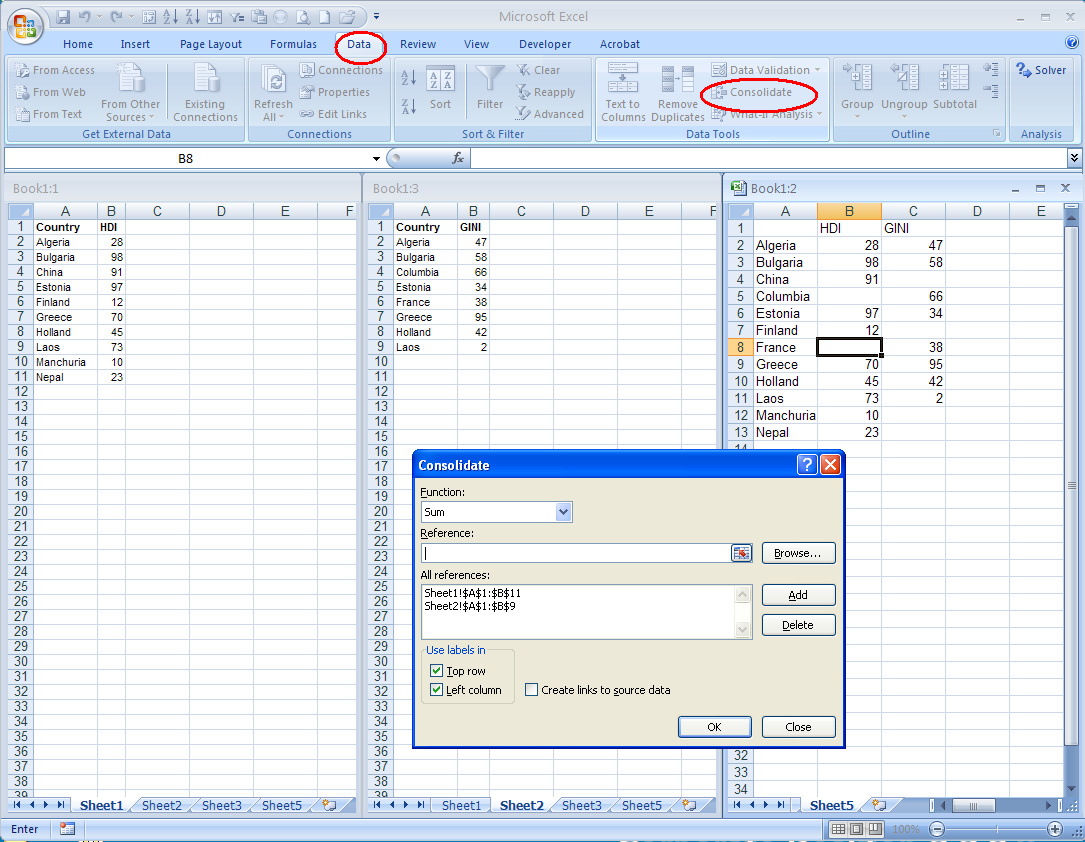5 Easy Ways to Merge Two Excel Sheets

Merging Excel sheets is a common task that often arises when working with datasets from different sources. Whether you're a business analyst, an accountant, or just someone managing a large amount of personal data, knowing how to efficiently merge data from different Excel sheets can save you a lot of time and manual effort. Here are five straightforward ways to combine data from two Excel sheets:
1. Using Excel's VLOOKUP Function

VLOOKUP (Vertical Lookup) is a fundamental function in Excel for merging data. Here's how to use it:
- Open your Excel workbook containing the two sheets you want to merge.
- Identify the common column in both sheets. This could be an ID, name, or any unique identifier.
- Suppose you want to merge data from Sheet1 into Sheet2. In Sheet2, choose a cell in the column where you want the merged data to appear. Assume the common identifier is in Column A of both sheets.
- In the target cell of Sheet2, type the following formula:
=VLOOKUP(A2,Sheet1!A:B,2,FALSE)
This formula looks up the value in A2 of Sheet2 in the range A:B of Sheet1, returns the corresponding value from the second column (B), and ensures an exact match with FALSE as the last argument.
🔍 Note: VLOOKUP only looks to the right of the lookup column, so make sure your data is arranged accordingly.
2. Power Query for Merging Excel Sheets

For those dealing with larger datasets, Excel's Power Query offers a more robust solution:
- Go to the 'Data' tab and select 'Get Data' then 'From Other Sources' and finally 'From File' -> 'From Excel'. Choose your Excel file.
- Once the Query Editor opens, you'll see your sheets listed. Click 'Advanced Editor' to manually combine the queries:
let
Source = Folder.Files("C:\YourFileLocation"),
#"Filtered Rows" = Table.SelectRows(Source, each [Extension] = ".xlsx"),
#"Combined Binaries" = Binary.Combine(Folder.Files("C:\YourFileLocation")[Content]),
#"Converted to Table" = Excel.Workbook(Combined Binaries, null, true),
#"Filtered Sheets" = Table.SelectRows(Converted to Table, each ([Kind] = "Sheet")),
#"Expand Sheets" = Table.ExpandTableColumn(Filtered Sheets, "Data", {"Column1", "Column2"}, {"Column1", "Column2"}) in
#"Expand Sheets"
3. INDEX-MATCH Function Combo

INDEX-MATCH is a powerful alternative to VLOOKUP, especially when your lookup column isn't on the left:
- Assuming Sheet1 has your primary data, and Sheet2 has the data to be merged, type this formula in the appropriate cell of Sheet2:
=INDEX(Sheet1!B:B,MATCH(A2,Sheet1!A:A,0))
🎯 Note: INDEX-MATCH is more flexible than VLOOKUP, allowing lookups to any column regardless of its position.
4. Using Excel's Merge Cells Option

For simple merging tasks where you want to combine data visually:
- Select the cells you want to merge.
- Right-click, choose 'Format Cells', and navigate to the 'Alignment' tab.
- Check 'Merge cells' and click 'OK'. This will combine the selected cells into one larger cell. You can then input data as needed.
5. VBA for Complex Merging

For those comfortable with coding, VBA (Visual Basic for Applications) can automate and customize the merging process:
- Press ALT + F11 to open the VBA editor.
- Insert a new module (Insert > Module).
- Type the following code:
Sub MergeSheets()
Dim ws1 As Worksheet, ws2 As Worksheet
Set ws1 = ThisWorkbook.Sheets("Sheet1")
Set ws2 = ThisWorkbook.Sheets("Sheet2")
Dim lRow1 As Long, lRow2 As Long
lRow1 = ws1.Cells(ws1.Rows.Count, 1).End(xlUp).Row
lRow2 = ws2.Cells(ws2.Rows.Count, 1).End(xlUp).Row
ws2.Range("A1:A" & lRow2).Offset(0, 2).Value = _
Application.Index(ws1.Range("B1:B" & lRow1), _
Application.Match(ws2.Range("A1:A" & lRow2), ws1.Range("A1:A" & lRow1), 0))
End Sub
🔄 Note: VBA scripts can be very useful but require some learning to use effectively.
In this journey through merging Excel sheets, we've explored different methodologies, from simple Excel functions to more advanced techniques involving Power Query and VBA. Each method has its advantages, depending on the complexity of the task at hand, the volume of data, and your comfort with Excel's functionality. Understanding these techniques not only boosts your productivity but also enhances your data analysis capabilities, making you more efficient and effective in managing datasets. Whether for business, academic, or personal use, mastering these Excel merging techniques is a valuable skill in today's data-driven world.
Can I merge data from two Excel sheets without using VLOOKUP?

+
Yes, you can use other methods like INDEX-MATCH or Power Query to merge data without relying on VLOOKUP. These methods provide different functionalities that might be more suitable depending on your specific needs.
Is there a way to automatically update the merged data when the source sheets change?

+
Yes, Power Query can refresh data automatically or on demand, ensuring your merged dataset is always up to date with changes in the source sheets.
What are the limitations of using VLOOKUP for merging Excel sheets?

+
VLOOKUP can only look to the right of the lookup column, can be slow with large datasets, and if the lookup column changes, you must adjust the formula. Additionally, it might not handle multiple matches as effectively as some alternatives.